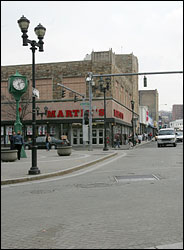 After more than a generation of debate, planning, and delay, the City of Yonkers hopes to bring life back to it's dormant downtown through a $3.1 billion redevelopment program. [SEE Amicone strikes $3.1 billion development deal for downtown Yonkers.]
After more than a generation of debate, planning, and delay, the City of Yonkers hopes to bring life back to it's dormant downtown through a $3.1 billion redevelopment program. [SEE Amicone strikes $3.1 billion development deal for downtown Yonkers.]The New York Times recently reported on the decades old plan to bring new life to Yonkers' declining downtown, an area suffering from the downturn witnessed by many cities and villages in the northeast, and now coming of age in Long Island, albeit on a far smaller scale. [SEE, Civic Fights Subside as Yonkers Hopes for $3.1 Billion Project.]
Step across Warburton Avenue, just three blocks to the east, and the pulse of a budding neighborhood suddenly flat-lines. There are boarded-up homes and empty storefronts, rotten wood and peeling paint. The shops in Getty Square, the heart of downtown, sell little beyond cheap furniture and dollar goods to the mostly poor, immigrant families who are their last loyal patrons.
Standing outside her home on nearby North Broadway, where the stoop wobbled under a visitor's feet, Graciela García, 29, said dejectedly, "I've given up hope that anyone can change the way things are around here."
"It's like we've been forgotten," Ms. García said, "like no one really cares."
Among planners, residents, and even displaced shop owners, there is concern amidst the eagerness to see the city's downtrodden downtown re-energized and revitalized. Indeed, many ask, can we have too much of a good thing?
Yes, remove the blighted warehouses and tear down the abandoned mills that block river views. But replace traditional "Main Street" with office/residential towers and a minor league ballpark sitting atop retail stores?
Okay, it could work. We are talking about a city, after all, and not a sleepy suburban hamlet aside a meandering creekbed. Still, both the economics -- and the aesthetics -- of scale must be closely observed here, lest the empty sidewalks and boarded up storefronts that flank Yonkers' Getty Square be transformed into empty sidewalks below cold-faced monoliths that not only block the river view, but sterilize what was once, some 30 years ago, a thriving downtown streetscape.
Downtowns are forever being rebuilt and reinvented -- shinning cities on the hill, by the bay, and overlooking the river. We must keep in mind, however, that physical redevelopment alone does not a community make. Revitalization is as much a state of mind as it is a state of being, and the dollars and cents poured in to downtown redevelopment must reflect, with clear foresight, that sense of place planners hope to recreate -- or create for the first time -- in redevelopment's wake.
- - -
Closer To Home: Long Beach, NY ~ The City By The Sea
 The City of Long Beach, which had reached the depths of economic and social depression by the late 70s, has fought its way back to near-resort status.
The City of Long Beach, which had reached the depths of economic and social depression by the late 70s, has fought its way back to near-resort status.The renaissance of Long Beach, as a viable and, yes, walkable suburban center, continues, with the City's "Master Plan" setting the stage for future redevelopment, and residents' involvement, so critical in assuring the vitality of both the physical and emotional sense of community, secured through an ongoing "visioning" process known as Charrettes.
For anyone who strolled the City's boardwalk in the 70s and 80s, Long Beach was a cold and desolate beachfront community, following the path of decline that stretched from Coney Island to the Rockaways. The transformation of Long Beach from a literal dumping ground to a premier choice of residence of the up and coming has been nothing short of remarkable.
A thriving "downtown" and a trendy "Main Street," panning out from City Hall, with vibrant shopping, dining and recreational venues -- as well as a transportation hub -- all within walking distance. [There is even a "Heritage Walk," a block-by-block, brick-by-brick tour of the story of Long Beach, past, present and future.]
Long Beach, Nassau County's own city by the sea, is doing fine and getting better, thank you. How's your town's physical and emotional sense of community?
Write us with your local views and perspectives at info@thecommunityalliance.org.
No comments:
Post a Comment